Titian Vecellio: life, major works, art
“Having adorned Vinezia, indeed all of Italy and other parts of the world, with excellent paintings, [Titian] deserves to be loved and observed by the artisans, and in many things admired and imitated, as those who did and still do works worthy of infinite praise, and will last as long as the memory of illustrious men can.” Thus the great Giorgio Vasari said of Titian Vecellio (Pieve di Cadore, c. 1490 - Venice, 1576), one of the greatest artists of the 16th century and of all art history. There were many innovations that Titian introduced, affecting both the painting itself and the role of the artist. In terms of style, Titian was able to renew Venetian tonal painting, building on the achievements of Giovanni Bellini and Giorgione, to lead it to levels of strength and vigor never before seen in Venice. Titian, in fact, was able to transfigure the solemnity and calmness of Giorgione’s compositions into opulent and energetic works thanks to the plastic value of his coloring. His art, which was capable of raising Venetian painting to previously unheard-of levels of drama and expressiveness, touched on a wide variety of themes: from religious painting to refined allegories, from mythological subjects to the abundant portraiture that led Titian to become one of the most sought-after painters of his time.
Titian, whose importance in the history of art is comparable, for example, to that of Raphael, Michelangelo, or Leonardo da Vinci (the Cadore painter was one of the great masters of color, and the reflections of his lesson would be felt for a very long time), is also of major importance because of the role he was able to embody: with Titian, by now, the artist had fully become an entrepreneur in his own right, capable of relying on a workshop with many helpers and collaborators, of organizing workshop activity as if it were that of a business, and of dealing as equals with patrons, all of whom in Titian’s case were of the highest caliber. To give an idea of the esteem in which Titian was held, an anecdote is told, particularly in vogue in the Romantic period: during a sitting for a portrait to Charles V, Titian is said to have dropped his brush, and the emperor bent down to pick it up and hand it to him. Of course, we have no certain evidence of this little story, but it is nonetheless interesting to report it in order to point out how Titian had succeeded (and this is entirely true) in raising artists to levels of consideration that they had probably never had before.
Titian’s career was extremely long, as the artist lived to be almost ninety years old and passed away in the 1670s, by which time the Renaissance season had ended, we were already in the midst of Mannerism, and an artist like Tintoretto, from a younger generation, was almost sixty years old and had already achieved the greatest successes of his career: nevertheless, despite his advanced age, Titian did not stop innovating. A man extremely adept at public relations, a tireless worker, capable of earning great riches through his art and racking up a series of great triumphs, Titian Vecellio can also be considered one of the first “European” artists, given that he worked for patrons all over the continent and that his lesson was also received outside Italy (just think of Rubens’ debts to him). All reasons that make his art great.
 |
| Titian, Self-Portrait (c. 1562; oil on canvas, 96 x 72 cm; Berlin, Gemäldegalerie) |
Titian. Biography.
Titian was born in Pieve di Cadore, to Gregorio Vecellio, who was a guardian of law and order by trade: he came from a wealthy Cadore family that also boasted a number of artists, but whose members were mainly dedicated to public administration. Of his mother, Lucia, we know very little. We do not know her exact date of birth, but it can be placed between 1488 and 1490. The artist remained in the mountains of his native land until around the age of ten: around 1498, in fact, he moved to Venice to an uncle named Antonio: in the lagoon city he became a pupil first of Gentile Bellini and then of Giovanni Bellini. He continued his training working as a collaborator with Giorgione: the artist worked together with him helping him in the execution of the frescoes in the Fondaco dei Tedeschi. In 1510 the artist moved to Padua, and in 1511 he began to work on his first major independent work: the frescoes for the Scuola del Santo, thanks to which he came to the attention of the upper echelons of the Venetian Republic.
In 1513 he returned to the capital, and the Serenissima entrusted him with the task of executing the Battle of Cadore for the rooms of the Doge’s Palace: this was his first official commission. He became the official painter of the Venetian Republic in 1516 and began to receive prestigious commissions. In 1518, for example, he finished painting theAssumption for the Frari church in Venice, commissioned two years earlier. In the same year he stayed in Ferrara to work for Duke Alfonso d’Este, and around the same time he was noticed by the Gonzaga of Mantua, who gave him further commissions. The following year he worked on one of his most famous works, the Pala Pesaro, which would be finished in 1526. In the 1520s he met the great man of letters Pietro Aretino: the friendship between the artist and the writer was destined to last through the years, until the Tuscan’s death in 1556, and together with Jacopo Sansovino they gave birth to the “triumvirate” that succeeded in directing the artistic and cultural life of mid-sixteenth-century Venice.
In 1525 Titian married Cecilia Soldano (who would die only five years later), and in 1530, thanks in part to the intermediary of Pietro Aretino, the painter came into contact with Emperor Charles V, for whom he would paint several portraits. Some of his best-known works date from the 1530s, for example the portraits of the dukes of Urbino, finished in 1538, and the very famous Venus of Urbino, which Titian finished painting in 1538. In about 1540 the artist executed theCoronation of Thorns, which is preserved in the Louvre, and in 1545, in an atmosphere of great anticipation, he arrived in Rome to work for Pope Paul III. In Rome, Titian also got to know Giorgio Vasari but was opposed by Perin del Vaga and Sebastiano del Piombo, the latter his rival from the days when the two were collaborators with Giorgione. On his return trip in 1546, he will have the opportunity to linger in Florence.
In 1548, Titian made a stay in Augsburg, Germany, where he had been summoned by Charles V, and where he would return for a second stay in the city. In the same year, 1550, Titian began working for the future King Philip II of Spain, and in 1551 he returned permanently to Venice, from where he would not leave again, except to sojourn occasionally in his native Cadore. In 1558 he began painting the Martyrdom of St. Lawrence for the Jesuit church in Venice, which was finished the following year: it is one of the most emblematic works of the last Titian. In 1566 the artist became an honorary member of the Accademia Fiorentina del Disegno, and in the same year the Venetian Republic abolished tax exemption for the painter, who until then had been able to enjoy a very favorable tax regime, which had allowed him to accumulate great wealth (however, Titian did not hesitate to evade taxes by declaring less income than he actually had and by omitting the declaration of several of his possessions). In 1572 he began to make theCoronation of Thorns now at the Alte Pinakothek in Munich, one of his last and most important works. He died in Venice on August 27, 1576, during a plague epidemic: his last work, the Pietà now at the Gallerie dell’Accademia in Venice, would be finished by Palma the Younger.
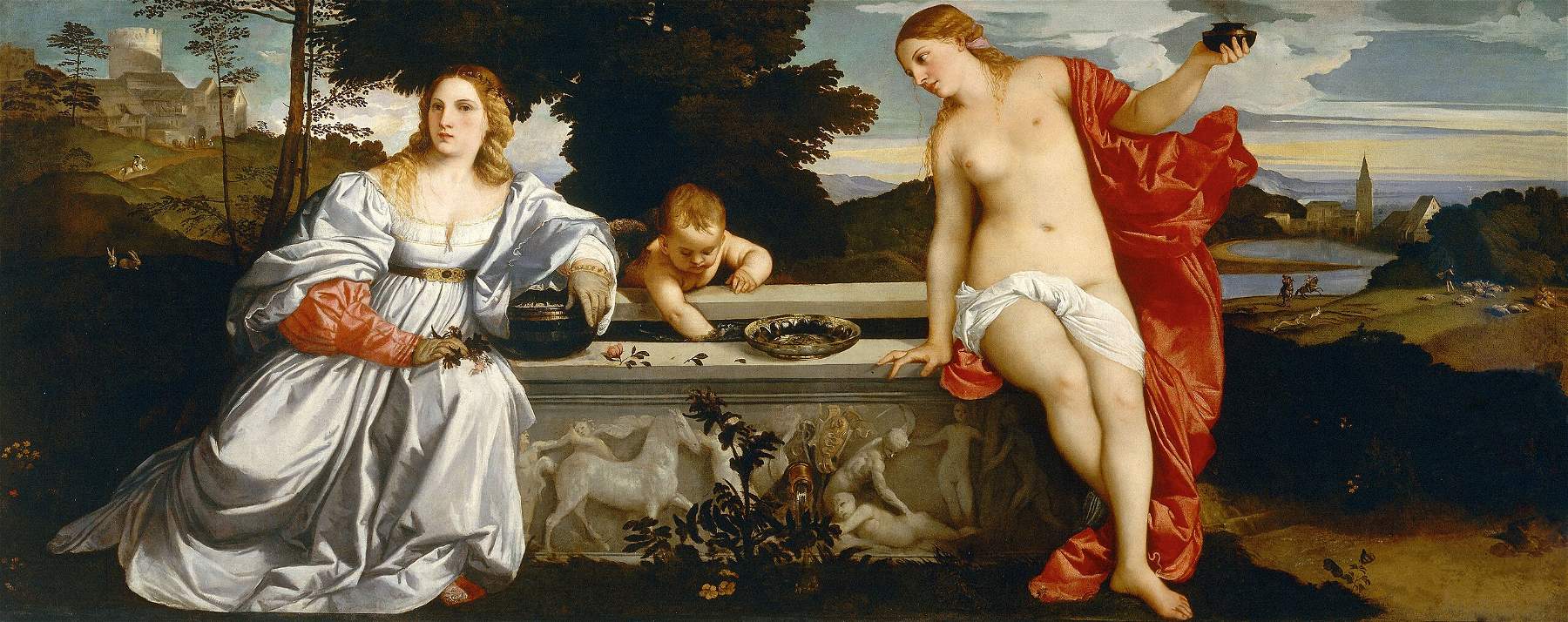 |
| Titian, Amor sacro e Amor profano (1515; oil on canvas, 118 x 278 cm; Rome, Galleria Borghese) |
Titian’s works: beginnings and innovations
Titian came to prominence from an early age with a number of youthful masterpieces, among which might be mentioned the Rural Concert, c. 1510, preserved in the Louvre. It is one of the cornerstones of tonal painting, that is, the technique developed in the Veneto starting with Giovanni Bellini (in the paintings of the Venetians there is no scientific perspective regulated by drawing as there is in contemporary Tuscan painting, nor is there contour: it is color that creates the plastic effects and it is also color that creates the effect of depth): here Titian moves from Giorgione, and at this stage his style is so similar to that of his older colleague that the Country Concert has often been attributed to Giorgione himself. Already appearing are the allegorical themes that the artist would deal with even later, with several of his masterpieces, for example the Amorsacro e Amor profano(a detailed discussion of the painting can be found here): Titian’s work is often underpinned by an important philosophical and literary framework, which the artist was able to explore in depth thanks in part to his many connections with the leading intellectuals of his time.
The real turning point with respect to Giorgione and his predecessors would come, however, with the frescoes of the Scuola del Santo: here the plastic value of color begins to become stronger and more vigorous than that of the artists who had preceded Titian, and above all, Titian’s painting begins to develop dramaticism and theatricality that thus open up new experimentation, previously unknown to Venetian art. With the Pala Pesaro come some important innovations, which, it can be said, close the season of the more solemn, balanced and harmonious Renaissance. The great novelty of the Pesaro Alt arpiece lies in the fact that Titian decides to abolish the classical central perspective setting: instead, the artist chooses to unbalance the composition to one side. The Madonna is no longer in the center but is on the right, and the architectural elements also undergo a revolution, with the two imposing columns rising in the center of the painting and we do not know where they end, and with the movement of the figures all oriented toward the Madonna: it was a painting that had to be looked at from the side so it is perhaps also for this reason that Titian chooses such a new setting. The colors become bright, notes of red prevail, one of our painter’s favorite colors, so much so that even today a particularly warm variety of red is known as “Titian red.” The Pesaro Altarpiece is therefore a theatrical, very lively, almost celebratory representation, a reflection of the historical moment: Venice at the time was experiencing a period of great splendor, a splendor that also enters into Titian’s art for much of his career.
However, there is also a more intimate Titian: we notice this, for example, in the Flora preserved in the Uffizi. Titian was very close to his wife Cecilia, and for him women are the bearers of love (which for Titian is above all conjugal love: indeed, Flora itself has been interpreted as an allegory of marriage), but they nonetheless have a strong erotic dimension: the fact that Flora has one breast covered and one uncovered could allude both to the bride’s fidelity and to the carnal dimension of women (a further reflection of an age when those who could afford it had no problem indulging in pleasures).
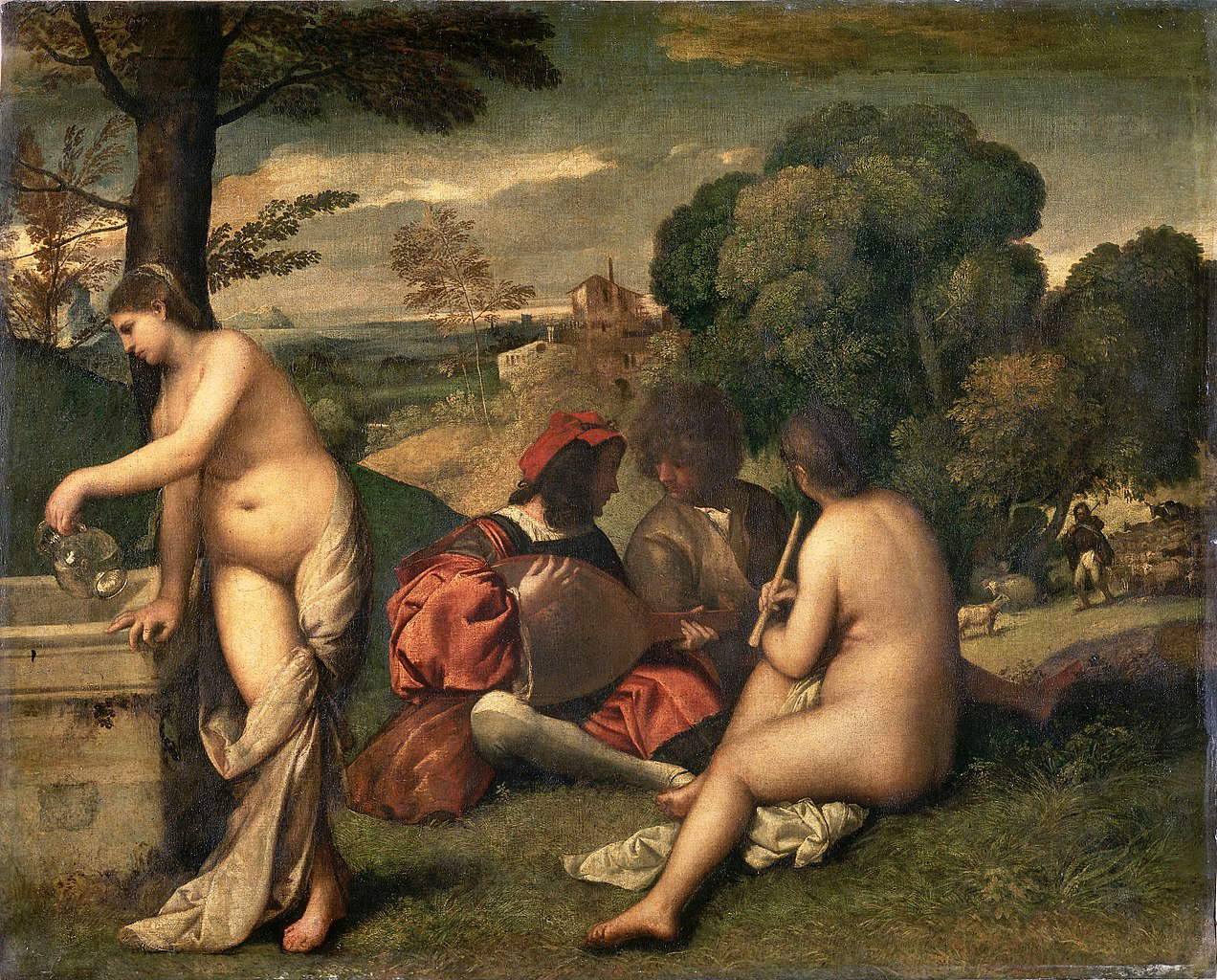 |
| Titian, Country Concert (c. 1510; oil on canvas, 118 x 138 cm; Paris, Louvre) |
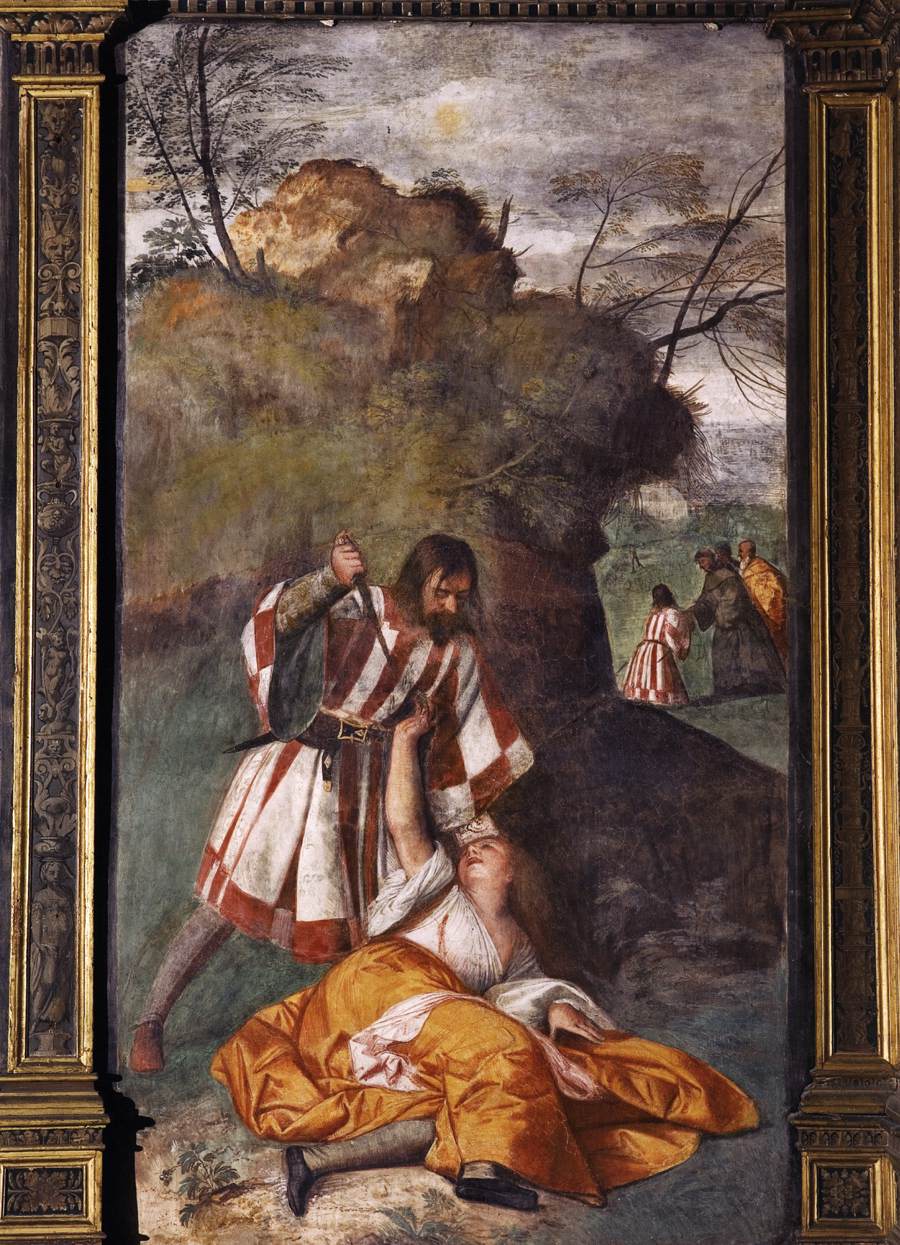 |
| Titian, Miracle of the Jealous Husband (1511; fresco, 340 x 207 cm; Padua, Scuola del Santo) |
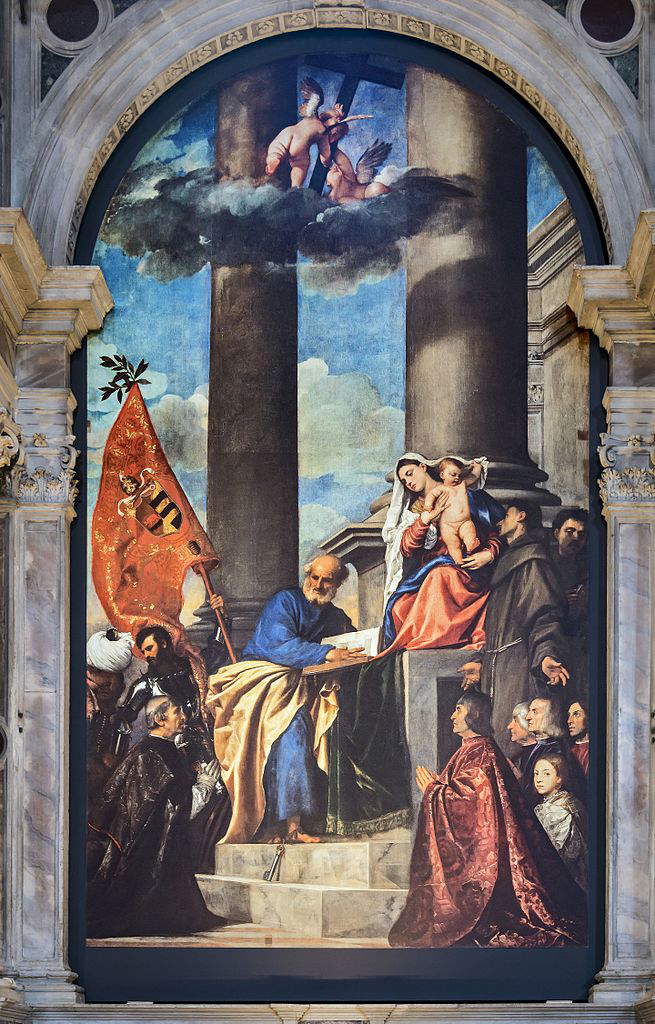 |
| Titian, Pala Pesaro (c. 1519-1526; oil on canvas, 478 x 268 cm; Venice, Basilica di Santa Maria Gloriosa dei Frari) |
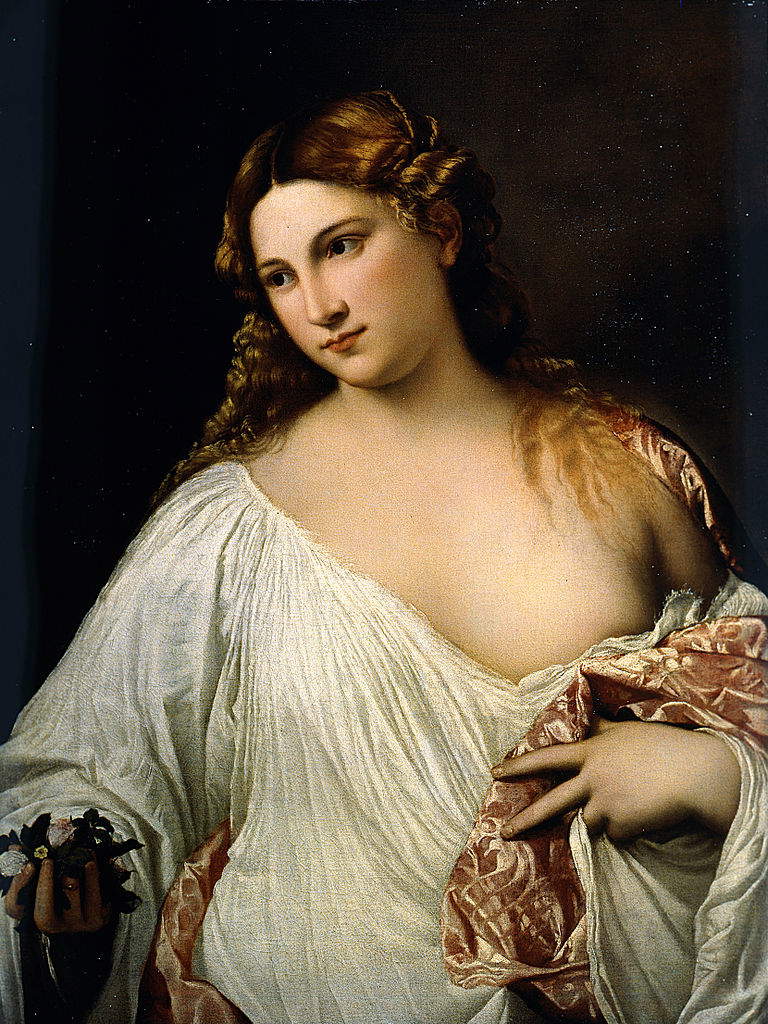 |
| Titian, Flora (c. 1515; oil on canvas, 79 x 63 cm; Florence, Uffizi) |
Titian’s works: mythology, portraiture, the last Titian
Among the most famous paintings by Titian, as well as in all of art history, is the Venus of Urbino, so called because it was executed for Guidobaldo II Della Rovere. Made in 1538, it is one of Titian’s most sensual paintings: the Venus is lying on the bed, looking at the viewer, one hand holds flowers and the other lingers on her pubis, at her feet we have a dog, and in the background we see a terrace and two fantesche who are looking for something in a chest. This could be another allegory of the bride in her double soul of faithful and sensual wife at the same time: the myth in Titian is never a representation for its own sake, it is not erudite painting, but as it happens in Renaissance art it is a way to communicate an allegorical or philosophical content, also in accordance with the wishes of his patrons.
Another fundamental strand in Titian’s production is portraiture (see, among dozens of examples, the portrait of Pietro Aretino preserved in Florence’s Palazzo Pitti). One of the most important features of Titian’s portraiture is his capacity for psychological introspection: Titian masterfully succeeds in penetrating the character portrayed to return an expression that always communicates a trait of his subject. In the portrait of Pietro Aretino, for example, there is an expression of pride, almost of haughtiness, a reflection of the character of the great man of letters. Another of the founding features of Titian’s portraiture, which moved from the portraiture of Antonello da Messina, is the use of the dark background, which was to influence much of later portraiture.
The last phase of Titian’s career, characterized by masterpieces such as the aforementioned Martyrdom of St. Lawrence, the Supplizio di Marsia or theIncoronazione di spine, is a phase in which the dramatic element reaches its peak: the brushstroke is broad, nervous and unstable, the colors become darker, and a sense of tragedy prevails. Moreover, the paintings made between the late 1560s and 1576, the year of the painter’s death, are all characterized by very dense impastos that sometimes form almost lumps of color, and also by the use of the painter’s own hand, which intervenes directly on the painting with the famous “finger rubbings,” to use the term of Jacopo Palma the Younger, a pupil of Titian: his painting becomes, in short, a kind of action painting ante litteram, and Palma the Younger himself in some of his writings gives a very detailed description of his Titian’s way of making art in his later days. The last work made by Titian, the Pieta of 1576 preserved in the Gallerie dell’Accademia in Venice and later finished by Palma the Younger himself, is another of the manifestos of this type of painting.
 |
| Titian, Venus of Urbino (1538; oil on canvas, 119 x 165 cm; Florence, Uffizi) |
 |
| Titian, Portrait of Pietro Aretino (1545; oil on canvas; Florence, Palatine Gallery, Palazzo Pitti) |
 |
| Titian, Martyrdom of St. Lawrence (1548-1557; oil on canvas, 500 x 280 cm; Venice, Church of the Jesuits) |
 |
| Titian, Pieta (c. 1576; oil on canvas, 351 x 389 cm; Venice, Gallerie dell’Accademia) |
Where to see Titian’s works
Works by Titian can be found in museums all over the world, but to get a full understanding of the artist, a visit to Venice is essential, starting with the Gallerie dell’Accademia, which holds several of his masterpieces. Also in Venice, one can complete the Titian “tour” by going to see the Pala Pesaro in the Basilica of Santa Maria Gloriosa dei Frari (a true temple of Venetian art of all times), and by visiting the Basilica of Santa Maria della Salute, the Jesuit church, the Doge’s Palace, the Scuola Grande di San Rocco, the church of Santi Giovanni e Paolo, and the church of San Salvador. Also in the region, to learn about early Titian, a visit to the Scuola del Santo in Padua is a must.
Great masterpieces by Titian can be found in many other Italian museums: the Uffizi (the Venus of Urbino, the Flora, the portraits of the dukes of Urbino, namely Francesco Maria della Rovere and Eleonora Gonzaga), the Palazzo Pitti (where the Penitent Magdalene and several portraits are found), the Galleria Borghese(Amor sacro e amor profano), the Pinacoteca Civica in Ancona (the Gozzi Altarpiece), also in Ancona you can see the Crucifixion in the church of San Domenico, and then again the Museo Nazionale di Capodimonte in Naples (the Danae, the Portrait of Paul III with his nephews Alessandro and Ottavio Farnese). Outside Italy, all the world’s great museums, from the Louvre to the National Gallery in London, from the Kunsthistorisches Museum in Vienna to the Prado, from the National Gallery in Washington to the Alte Pinakothek in Munich, preserve works by the great Venetian artist.
 |
| Titian Vecellio: life, major works, art |
Warning: the translation into English of the original Italian article was created using automatic tools. We undertake to review all articles, but we do not guarantee the total absence of inaccuracies in the translation due to the program. You can find the original by clicking on the ITA button. If you find any mistake,please contact us.




























